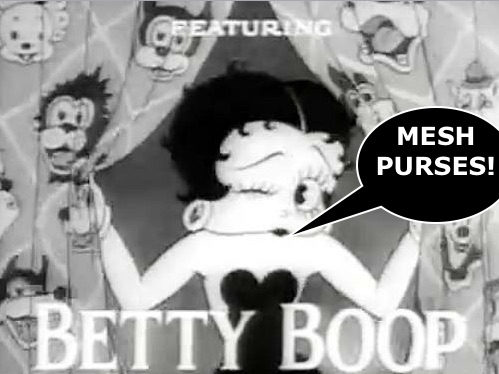
Made of pen and ink. She can win you with a wink. Wait `til you… get a view… of sweet Betty! (Lyrics from the Betty Boop cartoon series theme song.)
Can you name the favorite flappers of moviegoers in the 1930s? Silver screen devotees certainly flocked to see Marion Davies, Louise Brooks and Colleen Moore. However, the cartoon character, Betty Boop, was an even bigger box office draw than many of the flesh and blood actors. She starred in a total of 111 films between 1930 and 1939! And she was so popular that her likeness became one of the most frequently used images in mass merchandising during the Depression era. Betty’s image was licensed for a wide range of products including nail polish, cigarette cases, dolls, playing cards, and metal mesh purses.
Are you among the fortunate collectors who own a Betty Boop mesh purse? Apparently relatively few of these bags were made and even fewer remain after eighty-odd years. All of the circumstances that contributed to the scarcity of these purses today might never be known. However, one factor that undoubtedly had a major impact is the controversy that surrounded and shortened Betty’s cinematic career.
Betty Boop made her debut in Max Fleischer’s 1930 cartoon Dizzy Dishes, the sixth episode of his Talkartoon series produced by Fleischer Studios and released by Paramount Pictures. She also appeared in print in the comic section of a few newspapers starting in July 1934, but the comic strip never achieved the popularity of her cartoons. The daily strip ended after less than a year and the Sunday strip lasted only until November 1937.
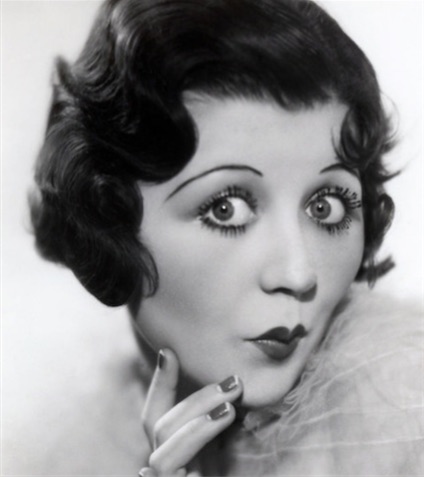
Helen Kane
Originally drawn as a humanlike French poodle caricature of singer Helen Kane, Fleischer’s character was changed to a completely human form in 1932. Betty, her floppy poodle ears morphing into hoop earrings and her black poodle nose becoming a tiny, turned-up button nose, was introduced as a Jazz Age flapper in the cartoon Any Rags. Black curls framed Betty’s face in all of her cartoons except Poor Cinderella (1934), in which she became a redhead for her only color film. She started out as a supporting character in ten cartoons and was portrayed as a scatter-brained flapper with a heart of gold. In stand-alone cartoons, she was billed under other names, including “Nan McGrew,” taken from the 1930 Helen Kane film Dangerous Nan McGrew, and was often cast as a girlfriend to Bimbo, the prevailing studio star at the time.
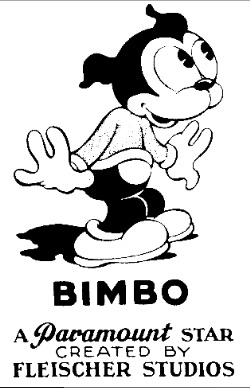
Bimbo 1930 to 1933
Bimbo was a purely fictional cartoon dog that appeared in Fleischer productions from 1930 through 1933. He was originally named Fitz in the Out of the Inkwell series, but later became the star of Fleischer’s Talkartoons series, making his first appearance as Bimbo in Hot Dog (1930). Bimbo was demoted to a supporting role when Betty Boop supplanted him as the most popular character in the Fleischer troupe. The Talkartoons series was renamed the Betty Boop series in 1932 beginning with Stopping the Show. Bimbo was banished from Betty’s series by the Motion Picture Producers and Distributors of America (MPPDA) Production Code when it was eventually decided that a dog with a human girlfriend was improper and violated the censorship rules that had been formally adopted in 1930.
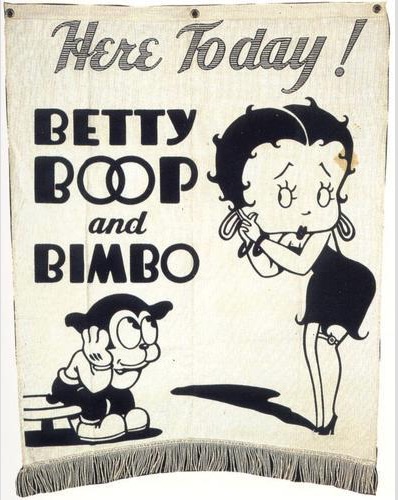
Betty Boop & Bimbo Circa 1932-33
Margie Hines was the first voice actress to speak for Betty. A few other actresses followed Hines until Fleischer discovered vaudeville performer Mae Questel in 1931. Questel initially shared the voicing role for Betty with other artists, but soon took it over exclusively. Remarkably versatile and talented, Questel was also the voice of Olive Oyl for twenty years. She even voiced Popeye in a few cartoons, as well as Casper and Little Audrey.
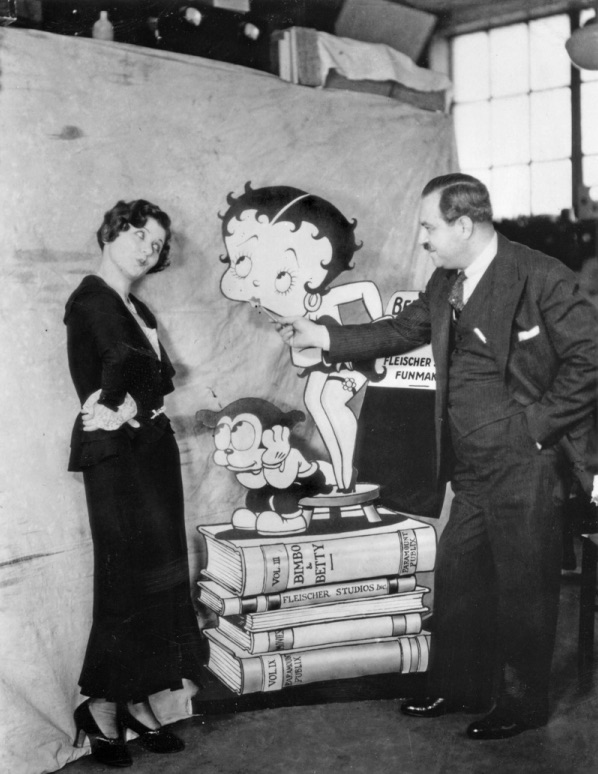
Mae Questel, the voice of Betty, with Max Fleischer
Betty’s signature phrase, “Boop-Oop-a-Doop,” has no meaning out of context. It was inspired by “scat,” a style of jazz singing that was popular during the 1920s and ‘30s. Improvisational scat singers strung together groups of words and alliterative sounds that were intentionally nonsensical. Cab Calloway recorded a tune actually named The Scat Song in 1932 that contains the following lyrics:
When your sweetie tells you, everything’ll be okay; Just skeep-beep de bop-bop beep bop bo-dope skeetle-at-de-op-de-day!
If you feel like shoutin’, advertise it just this way: And skeep-beep de bop-bop beep bop bo-dope skeetle-at-de-op-de day!
Although the invented phrases are meaningless, the way Calloway employs them imparts meaning.
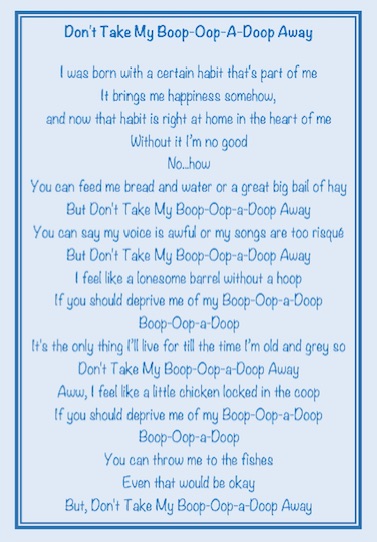
Don’t Take My Boop-Oop-A-Doop Away
An example of scat can be found in Betty’s 1932 film Boop-Oop-a-Doop, which takes place in a circus. Upon returning to the wardrobe tent after her tightrope act Betty finds herself fighting off the ringmaster’s unwanted advances. Koko the clown hears Betty struggling and arrives just in time to rescue her. When Koko asks if Betty survived unscathed, she answers, “He couldn’t take my Boop-Oop-a-Doop away!”
April 1932 Photoplay Magazine Article
Helen Kane filed a $250,000 infringement lawsuit against Max Fleischer and Paramount in 1932. Her suit charged that “deliberate caricature” perpetrated by the defendants had produced “unfair competition,” exploiting both her singing style and appearance. Kane had been a star of stage, recordings and films for Paramount and had risen to fame in the late 1920s as “The Boop-Oop-a-Doop Girl,” but by 1931 her career was flagging. As Kane’s career waned Paramount promoted the development of Betty Boop more vigorously. The case was finally heard in New York in 1934. Fleischer stated in court that Betty Boop was purely a product of his imagination, and other evidence proved that Kane’s “look” was not as distinctive as she claimed. Both Kane and the Betty Boop character bore a close resemblance to Paramount star Clara Bow. Even more crucial to the final verdict was the rejection of Kane’s claim regarding the uniqueness of her singing style. It was revealed that a few years earlier Kane had attended a performance by Baby Esther, an African American singer that employed a similar vocal style. A Baby Esther test film was also introduced into evidence featuring the singer performing in the “Jazz Baby” style. New York Supreme Court Justice Edward J. McGoldrick ruled against Kane, concluding that she had not originated the “baby” style of singing and that she had failed to prove that her physical appearance was unique.
Clara Bow
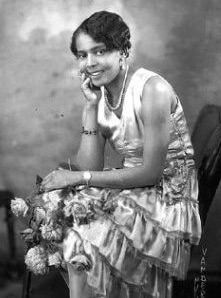
Baby Esther
Betty Boop’s early cartoons were aimed at adults and are considered her best due to her combination of girlishness, maturity and innocent sexuality. She was the flapper personified to many motion picture fans. However, the National Legion of Decency and the Production Code of 1934, commonly known as the Hays Code, significantly impacted the content of her films. The Hays Code imposed detailed restrictions on the type of content films could reference with sexual innuendo, and its implementation put an end to flouting of the largely unenforced rules adopted in 1930. This turn of events had a profoundly negative effect on the Betty Boop cartoons.
Joseph Breen, the new head film censor in 1934, lodged numerous complaints about Betty’s cartoons. Breen ordered the removal of the risqué introduction that started each cartoon because Betty’s flirty winks and swiveling hips were regarded as “suggestive of immorality.” No longer an uninhibited flapper often pursued by lecherous men, Betty was now portrayed as a schoolteacher, secretary or babysitter who usually wore a modest dress with an almost puritanical hemline. There was a gradual decrease in the number of curls in her hair, and her gold bracelets and hoop earrings disappeared. Even her personality changed as she became more mature and less frivolous. To replace the objectionable Bimbo, Betty was furnished with a boyfriend, Freddie, who was introduced in She Wronged Him Right (1934). In an effort to make her more family-friendly Betty became the owner of a pet puppy named Pudgy that was first seen in Betty Boop’s Little Pal (1934). In 1935 a further effort to make her more appealing to a younger audience was attempted with the addition of Grampy, an eccentric inventor.
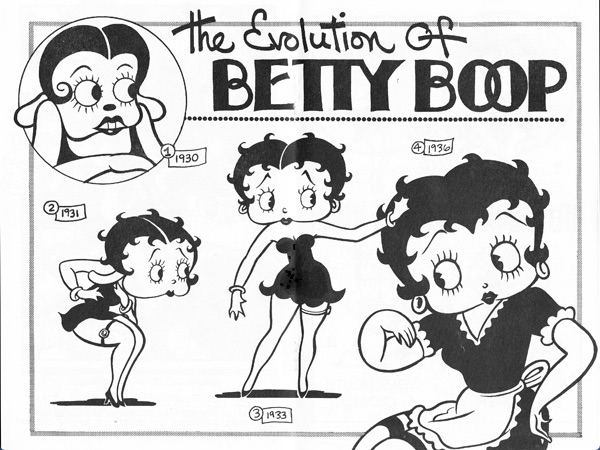
Betty Boop’s Evolution: Poodle >> Pin-up >> Prim & Proper
All of these ploys to charm adolescent viewers resulted in Betty’s post-Hays Code cartoons being much more subdued than her earlier films. Unfortunately, Betty’s transformation contributed substantially to the decline of the series. Some of the falloff was also due to cutting back Betty’s role in the cartoons in favor of her co-stars. A similar issue developed during the same period at the Walt Disney Studios with Mickey Mouse, who was becoming overshadowed by the popularity of his co-stars Donald Duck, Goofy and Pluto.
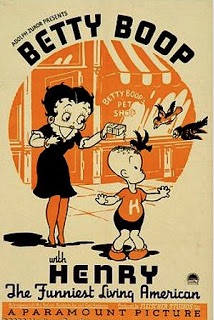
Betty Boop and Henry 1935 – Post Hays Code
Fleischer Studios artists worked diligently to keep Betty’s cartoons relevant to youngsters and balance out her frequent musical scenes by teaming her with popular comic strip characters such as The Little King and Henry. They also tried to create a spin-off series in 1933 by pairing her with Popeye, Fleischer’s most successful character. However, none of these combinations proved popular enough for Betty’s series to regain its former status.
In the late 1930s the swing era succeeded the Jazz Age that Betty originally represented. Fleischer Studios made a bid to develop a swing-style character in the 1938 cartoon Betty Boop and Sally Swing, but the film was not a box-office success. Despite a few more futile attempts to transform Betty into a swing era star Flesicher’s efforts couldn’t overcome the changes wrought by controversy. In her last appearance, Rhythm on the Reservation (1939), Betty drives a convertible labeled “Betty Boop’s Swing Band” onto a Native American reservation, where she introduces swing music and even creates a “Swinging Sioux Band.” The Betty Boop cartoon series officially ended in 1939 with the release of Yip Yip Yippy, a film in which Betty didn’t actually appear.
Betty Boop Mesh Purse Circa 1933-34
There are two known varieties of Betty Boop mesh purses, and perhaps other versions that have not yet surfaced. The first shows just an image of raven-haired Betty standing, hands on hips, in a pre-Hays Code red dress inside an oval vignette with her name in red letters below. The second purse shows Betty in the same red dress, but with red hair and bent over at the waist, hands on her knees, watching Bimbo juggling three balls. Bimbo sports a red shirt, black pants and oversized shoes. Betty and Bimbo are framed by a winding black line embellished with loops, curlicues and flourishes. Below the two images “Betty Boop” is written in upper case block letters, just as on the first purse. However, on the first purse her first and last names are both on the same line. On the second purse the word “Betty” is positioned above and mostly to the left of “Boop.”
Image 1031 – Betty Boop & Bimbo Mesh Purse – W&D bowtie trademark and COP D.S. Fleischer Studios Inc. stamped on frame; Rowan (Ivorytone) Mesh; 3” x 4-1/2”
Otherwise both purses share many of the same characteristics. The background color of the mesh on both purses is cream and the frame is painted to match. The respective images are painted on both sides of the purses. They are both made with Rowan (Ivorytone) mesh cut on the bias. Both are stamped inside the frame with the Whiting & Davis bowtie logo and “COP DS Fleischer Studios Inc.” Each purse is approximately 4-1/2” long on a 3” frame with a short oval-link-chain handle.
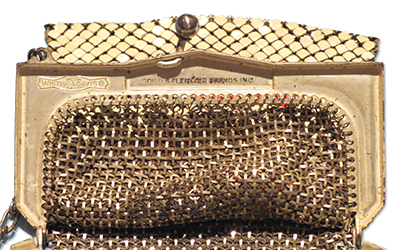
W&D Logo and Fleischer Copyright Stamped Inside the Frame
One clue to determining the approximate manufacturing date of the Betty Boop mesh purses is knowing the type of mesh used to make them. The inventor of Rowan (Ivorytone) mesh, Harry B. Rowan, filed an application for a design patent for his new flat mesh with rounded corners in June 1930, which resulted in a patent award in March 1931. Rowan mesh eventually became the standard type of mesh for all Whiting & Davis flat mesh bags and it continued as the standard for many years. This information helps by defining the earliest possible date of manufacture, but does nothing to aid in establishing the latest possible date.
Little is known about licensing agreements for Betty Boop commercial products in the 1930s. Neither Whiting & Davis nor Fleischer Studios have records dating back that far. However, in a November 1934 copyright infringement suit brought by Fleischer a Mr. Joseph P. Kallus was named as the licensee that was granted exclusive rights to make and distribute toys and dolls. On a date after July 1931 not specified in the suit, Fleischer Art Service, owner of the Betty Boop copyright, sold the exclusive rights to Mr. Kallus for a period of five years. Kallus became involved with doll and toy manufacturing while still an art student in New York. He worked for a series of doll makers until 1922 when he founded his own business, the Cameo Doll Company of New York. In 1933 he moved the company to Port Allegheny, Pennsylvania. Apparently it was Mr. Kallus’s company that contracted with Whiting & Davis to manufacture the Betty Boop purses. So we can surmise from these facts that the bags must have been made after 1931 and before 1939, but in order to narrow down the manufacturing period we must study Betty’s cartoons for additional evidence.
Assuming that Betty’s images on the mesh purses closely mirror her cartoon history, identifying the approximate dates the purses were produced becomes clearer. To recap…
- Betty’s character in her familiar human form debuted in 1932.
- Bimbo appeared in Fleischer cartoons from 1930 to 1933.
- The Hays Code went into effect in July 1934.
- Betty’s style of dress on the purses is pre-Hays code.
- Redheaded Betty was featured only in Poor Cinderella, released in August 1934.
- Although Betty’s cartoons were toned down soon after adoption of the Hays code, changes to the length, neckline and style of her dress weren’t completed until October 1934.
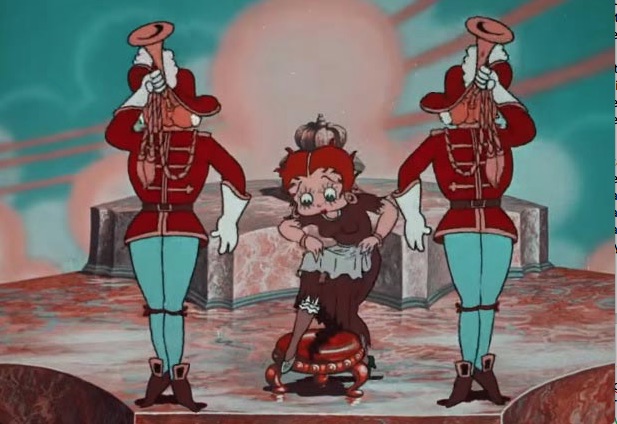
Cinderella 1934 – Betty as a Redhead
Keeping all of these facts in mind, we can conclude that the black-haired Betty Boop purse could have been made anytime from 1930 to September of 1934, but most likely was made between late 1933 and the middle of 1934. The red-haired Betty Boop and Bimbo mesh purse was probably made in the Hays Code transition period around July 1934 to leverage the anticipated popularity of the one and only Betty Boop color cartoon.
Even though a direct link cannot be made, no doubt certain consequences of the Great Depression stifled sales of Betty Boop mesh purses. Unemployment skyrocketed from 3.2% to 25% between 1928 and 1933 and during the same period cinema attendance plummeted by 56%. In 1933 Paramount, and its Paramount–Publix chain of 1,500 movie theaters, filed for bankruptcy and began a financial reorganization. Dramatic changes to family life ensued as young couples, worried about their finances, put off having children. The number of children born to women aged 15 to 44 declined by almost 20% from 1928 to 1935.
A more distinct correlation can be made, however, between low sales and Betty’s fall from grace in the film industry. From the time the Hays Code was installed Betty’s popularity suffered a rapid decline. The timing could not have been worse for the manufacturer and distributor of the Betty Boop mesh purses. Both Whiting & Davis and Cameo must have been dismayed by the effect strict enforcement of the Hays Code had on interest in their cute child’s purse. After Betty’s morality had been called into question how many parents do you suppose would have rushed out to buy their daughter a Betty Boop mesh purse? Although at the height of her fame Betty’s films drew as many moviegoers to the box office as rivals Mickey and Minnie Mouse, the less controversial characters in tamer cartoons enjoyed much longer periods at the pinnacle of popular culture. Not surprisingly, more of the mesh purses depicting these characters are available to collectors today.
And because Betty Boop mesh purses are child’s purses, and young ladies were frequently exuberant when playing with their possessions, it is extremely difficult to find a surviving example in top condition. Today’s purse collectors compete with each other, but also with cartoon character collectors and Betty Boop enthusiasts for the elusive prize, all of which might move the lucky individual who finds one of these rare purses to excitedly exclaim…Boop-Oop-a-Doop!
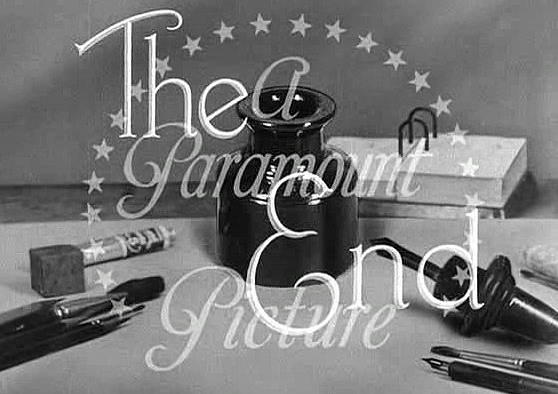

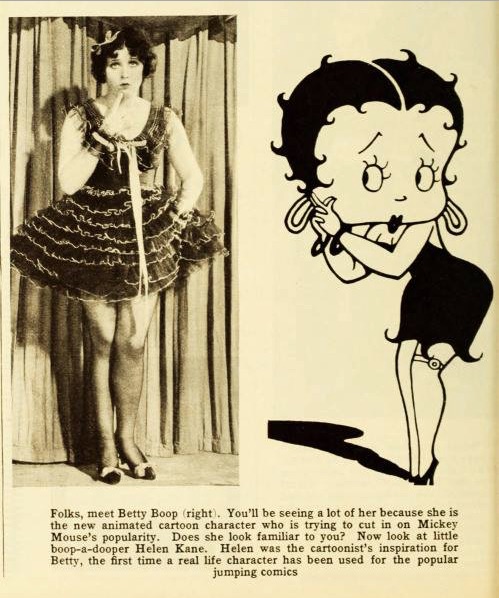
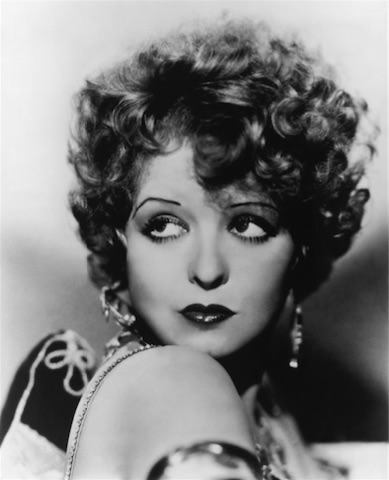
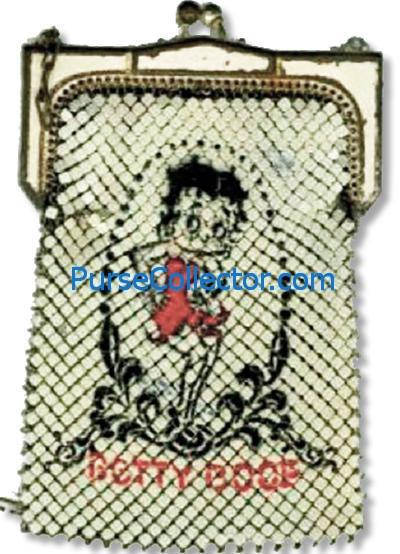
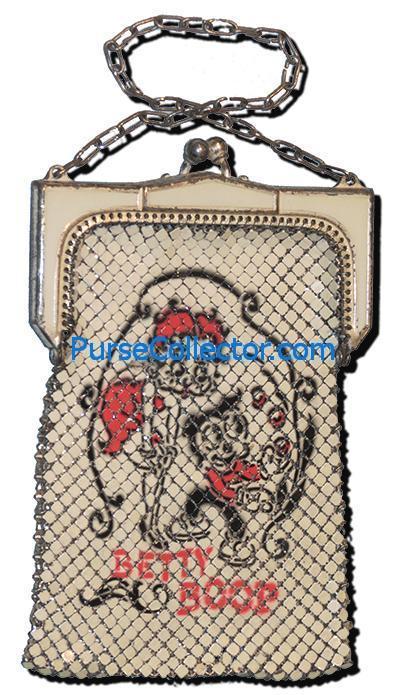
Sherry & Mike
Your article was, as usual, both entertaining and informative.
Sally Hoffman
Thanks, Sally! Those are qualities we strive for in our articles.
Dear Mike & Sherry,
Another enjoyable article! It was interesting how historical events and values affected the rise and fall of her popularity. Had to laugh to read they changed Bimbo because it was inappropriate for a human to have a dog boyfriend. Thanks for sharing your research and collection. Are you familiar with a felt flapper purse ? Is that a depiction of Betty?
Thanks for your comments. Although “rare” is a term often misused in relation to mesh purses in our opinion it is appropriate to apply it to Betty Boop mesh purses. We have often pondered what makes a mesh purse truly rare. This was our premise for developing the article. Of course some of our conclusions are speculative, but we think they paint a compelling picture when considered in total.
As for the felt purse, if it is the one we’re thinking of…Yes, we are familiar with it. We’re not experts on fabric purses, but we don’t think it was intended to portray Betty. The image on the felt purse is clearly that of a little girl in appearance and dress. Betty’s image was that of 17 going on 25 in a young woman’s clothes.